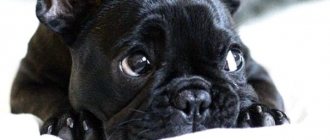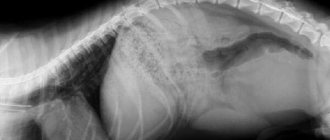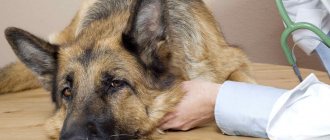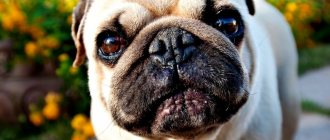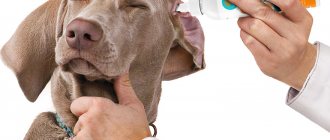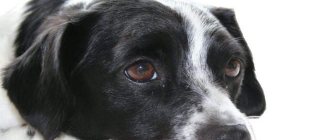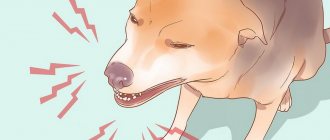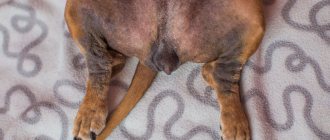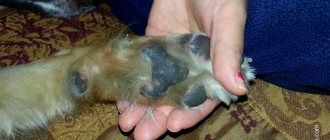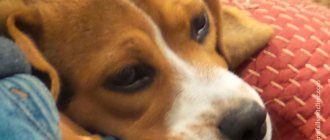The complex of daily pet care includes examination of all mucous membranes: eyes, nose and mouth. Inexperienced owners are very worried when their dog’s eyes become sour, and this worry should not be called unnecessary. Sour eyes may indicate the development of another and more serious illness, but to understand what to do, you need to identify the reasons for your pet’s poor health.
General information about diseases
Diseases of the eyes and individual parts of the visual apparatus are a serious problem, which often leaves irreparable consequences (all kinds of deformations, blindness). All diseases are divided into 3 types:
- Infectious – problems that develop due to previous or untreated viral diseases, both of the eye itself and other organ systems;
- Non-infectious or mechanical - traumatic injuries, ingrown hair follicles, etc.;
- Congenital - genetic (some breeds have a tendency to certain diseases), resulting from improper intrauterine development.
Each type of treatment addresses different causes. Therefore, it is important to consult a veterinarian to determine the true nature of the problem.
Prevention measures
Preventive measures will make it possible to avoid sour eyes. Particular attention should be paid to breeds with long hair and flat faces .
Prevention measures:
- Treat eyes daily. To do this, just wipe them with a cotton pad soaked in boiled water.
- Monitor the animal's diet. Avoid fried, salty and sweet foods.
- Trim long hair in the eye area.
- Avoid contact with stray animals.
- Treat your dog for fleas and ticks.
- Provide the animal with a clean place to sleep and eat.
- If a foreign body gets in, it must be removed immediately.
- Visit your veterinarian regularly to rule out diseases of the internal organs. It is especially important to treat the genitourinary system.
Hygienic procedures are selected individually for each breed. For short-haired cats, it is enough to wash their eyes and monitor their condition. Longhaired cats have their fur cut monthly.
Problems and diseases of the eyeball
These diseases are classified as mechanical or genetic . Some breeds are prone to all sorts of dislocations and deformations of the white part of the eye. These include brachycephalics (Pekingese, Shih Tzu), whose eye orbit is smaller or larger than the size of an apple.
Recession of the eyeball (Horner's syndrome)
More often it is a congenital disease, typical for puppies from small, weak bitches. It is expressed by a reduced eye (or two) with a wide palpebral fissure. In this way, atrophy of the eye occurs due to flattening or its retraction. Symptoms: pronounced difference in the size of the orbit and organs of vision, frequent blinking (uncontrolled), prolapse of the third eyelid. It can only be treated surgically.
Eyeball luxation
The second name is exophthalmos . In this case, often a genetic hereditary disease, the eye is displaced beyond the orbital bone. Even with a slight protrusion of the apple beyond the eyelash area, the veterinarian will make this diagnosis. Traumatic exophthalmos can lead not only to orbital dislocation, but also to eye prolapse in a dog.
The main causes of the disease: weak eye muscles, shallow orbital cavity, severe bruises of the head and muzzle. At the moment of impact, the pressure inside the visual organs increases greatly, causing the capillaries to burst. Therefore, the main symptoms are a red eye, an unnatural position of the apple.
In case of loss, you need to apply a cloth moistened with warm water to the eye and urgently take your pet to a veterinary clinic. The specialist sets the organ and applies stitches. After this, anti-inflammatory therapy and antibiotics may be prescribed.
| List of drugs for treatment | ||
| Name of medicine | Price | Release form and application |
| Novocaine | 20-40 rubles (100 ml) | The solutions are not used individually, but in total; 0.5 ml, 02-03 ml, 0.2 ml are injected under the conjunctiva, respectively, 4-5 days in a row after 6 days of wearing the bandage |
| Gentamicin | 100 rubles (100 ml) | |
| Dexamethasone | 300 rubles (100 ml) | |
Wool
The good condition of the pug's coat is responsible for its neat appearance. You need to bathe your dog only when necessary - frequent washing can cause harm to the pet, since the pug's skin is covered with a biologically active film, which, when washed off, causes the skin to become covered with dandruff, and the hair becomes brittle and dull.
When washing, you need to cover the dog's ears with cotton swabs and protect the eyes. It is necessary to use a special shampoo for short-haired dogs, choosing which should be based on the characteristics of the skin and the condition of the coat. After the procedure, you should wipe the pug dry, give it a shake and dry it with a hairdryer. comb your pet with a stainless steel iron comb every week, and daily during shedding.
The fur near the mouth should be combed carefully, and the ears should not be touched.
A haircut
Pugs have a short coat, however, from time to time they need a partial haircut to make grooming easier.
In addition, a haircut is a prerequisite for a pug to participate in exhibitions or competitions, as well as in the presence of skin diseases, fungal infections, cuts and abrasions.
The most common option for cutting a pug is to shorten the hair along the body by 1.5 cm and straighten the hair on the “pants” and tail with thinning scissors. The fur is trimmed with a special clipper in the direction of hair growth.
Because the coat is too short, the pug's skin becomes vulnerable and prone to burns. Therefore, it is necessary to carefully care for it using various moisturizing creams and lotions.
Diseases of the conjunctiva and lacrimal apparatus
The disease develops due to exposure of the irritant to the membrane, and later to the conjunctiva . It is divided into several subtypes depending on the nature of the virus or allergen. Often found in animals with large eyes and long hair (Yorkshire Terriers, Poodles).
Conjunctivitis (purulent, allergic, follicular)
Conjunctivitis is an inflammation of the mucous membrane and inner eyelid, caused by various reasons: ingress of wool and objects; allergy; infection; ingrown eyelashes; eye injury. The disease is difficult to cure and can develop into a chronic form.
The main types of conjunctivitis are purulent, allergic and follicular . Their symptoms are the same: redness of the whites, the dog’s eyes fester, the conjunctiva and third eyelid swell, restlessness, anxiety, the intention to wipe away dried particles of pus and tears.
The allergic form develops in the presence of an irritant - pollen, small debris and dust, insects. It can be a consequence of poor nutrition or care (poor quality shampoos and hygiene products). Treatment takes place in several stages:
- Isolation from the allergen (removing it from food, consumption; washing the eyes with chamomile decoction or saline solution);
- Administration of an antihistamine (injections or tablets), eye drops (to soothe irritation).
Purulent conjunctivitis is a consequence of infection with a virus or infection, and is often a symptom of other serious diseases (canine distemper). Therefore, before treatment, you need to contact a specialist to conduct additional tests. The disease is treated with antibiotics: eye ointments and drops. First, wash the eyes with chamomile decoction or strong tea.
The most important symptom of the follicular type is purulent blisters on the inside of the eyelid. The conjunctiva becomes bright crimson. The disease is a consequence of the ingestion of toxic wastes and substances, or develops as a chronic form of purulent conjunctivitis. Veterinarians perform surgery to excise the conjunctiva and prescribe treatment with antibiotic ointments.
| List of drugs for treatment | ||
| Name of medicine | Price | Release form and application |
| Tsiprovet | 200 rubles (10 grams) | Eye drops are used for 1-2 weeks several times a day (1-2 drops in the affected eye); used to soften purulent growths (2-3 drops and wiping with a cotton swab) |
| Tetracycline ointment | 120 rubles (40 grams) | 3 times a day, the ointment is applied to the inner side of the lower eyelid and distributed over the entire surface (the preparation is first heated to room temperature) |
Keratoconjunctivitis
Dry eye syndrome or lack of tears that lubricate the membrane and wash away all germs and dust . The main and most common cause is inflammation of the lacrimal gland. The disease can be congenital and is common among Spaniels, Bulldogs, Pugs and other breeds. The problem becomes a consequence of various post-traumatic neurological disorders, allergies or reactions to anesthesia, removal of the third eyelid.
Symptoms: the animal’s eyes become watery and red, blinking becomes more frequent, the integrity of the cornea is compromised, ulcers appear, suppuration, partial blindness, and the third eyelid falls out.
Treatment depends on the nature of the infection. First of all, moisturizing drugs are prescribed to restore the lacrimal environment. If a virus is present, antibiotics are used. If ulcers are noticed on the surface of the cornea, surgery is required.
| List of drugs for treatment | ||
| Name of medicine | Price | Release form and application |
| Hyphenation | 30-80 rubles per bottle | Eye drops of a thick and viscous consistency are used depending on the severity of symptoms, have an anti-inflammatory and anti-allergenic effect; base – hypromellose |
| View-dresser | 200-400 rubles | Povidone solution 2%, used only as a humectant, to eliminate burning and other uncomfortable sensations |
| Tobrex | 175 rubles (5 ml) | Broad-spectrum agent: fights infection, moisturizes, removes germs and foreign bodies; use interval – 10 days (5-7 times a day, 1-2 drops) |
How to help your pet at home?
In simple cases, when the pet’s eyes are watery despite their overall healthy appearance, the owner can provide help at home. First, you should inspect the animal:
- Place your pet in front of you. Gently spread your eyelids apart with your fingers. Examine the eye carefully.
- Evaluate the structure of the discharge and the color of the eyelids. Normally they have a pale pink tint.
- Check for the presence or absence of foreign bodies and visible damage.
Now about what to do and what means to use. If you need to rinse your eyes, you should use a sodium chloride solution. It will also help wash away the foreign body.
In order to cope with an allergic reaction to pollen, you need to give your pet Cetirizine. Daily dose – 1 tablet. If you have a food allergy, you need to remove the food that triggers it from your diet.
To eliminate inflammation and itching, you can brew chamomile flowers (1 sachet per glass of hot water). Leave for 15 minutes. Soak a cotton pad in the cooled solution and carefully wipe the animal’s eyes. “Diamond Green” drops are very helpful against swelling.
If after 5 days the problem has not been resolved, you need to show the animal to a specialist.
Attention!
Do not self-medicate if you cannot determine the exact cause of your pet's tearfulness.
Upper and lower eyelid problems
Diseases associated with or characterized by inflammation or deformation of the eyelid. They arise due to infection or congenital predisposition.
Blepharitis (inflammation of the eyelid)
Inflammation can be unilateral or bilateral . In the first case, the cause is infection or injury. In the second - chronic diseases, demodicosis, allergies, staphylococcus.
Symptoms of the disease: severe swelling and redness of the lower and upper eyelids, hair loss around the eyes and fur, ulcers and wounds on the surface of the eyelid.
Treatment consists of soaking the crusts with herbal decoctions (chamomile, sage, green and black tea), using antibiotics and anti-allergenic drugs.
| List of drugs for treatment | ||
| Name of medicine | Price | Release form and application |
| Metronidazole | 80 rubles (40 grams) | The ointment is prescribed for the treatment of blepharitis when infected with parasites |
| Hydrocortisone ointment | 30-40 rubles per tube (10 grams) | Apply 2-3 times a day for 1-3 weeks; has anti-allergenic and anti-inflammatory effects |
Eversion of the century
A mechanical or paralytic disease characteristic of animals with mobile excess skin (folds) and a wide orbital fissure (eg, Basset Hound). Occurs during surgical removal of wounds, pinched nerves, and sagging skin.
Symptoms: mucous discharge, inflammatory processes in the conjunctiva, redness of the inner side of the lower eyelid, non-closure of the upper and lower eyelids. It can only be removed and corrected surgically.
Turn of the century
A unilateral inversion of the corner of the upper eyelid occurs. A genetic congenital disease that manifests itself during the first year of life. Often found in breeds with abundant folds on the face and body - Shar Pei, Chow Chow, Mastiffs.
Symptoms: deformation of the eyelid, redness, tearing. It can only be treated surgically.
Folk remedies
Medication treatment is not always allowed for animals. In this case, folk methods of treating eyes from pus will help.
Folk remedies:
- Strong black tea. They wash their eyes.
- Fresh aloe juice diluted in water. Proportions: 1 tbsp. juice per 200 ml of water.
- Freshly squeezed carrot juice with vegetable oil (added to food). This remedy helps improve immunity.
If there are allergic reactions, you should review your dog’s diet and eliminate harmful foods. Dishes must be fresh.
Uveitis
Inflammation of the mucous membranes and irises, from which no dog is immune. The reasons are different: trauma, internal chronic diseases, infection or virus. Symptoms: inflammation of the eye, change in iris color (cloudness), decreased vision, photophobia (the dog hides in dark places), severe pain and half-closed eyelids. Treatment is aimed not only at eliminating pain and inflammation, but also at preserving vision.
| List of drugs for treatment | ||
| Name of medicine | Price | Release form and application |
| Rimadyl (base – carprofen) | 500-650 rubles per plate of tablets (10 pieces) | The product is used to reduce inflammation and relieve pain; The drug comes out in the form of a syrup, the dose is selected only on the recommendation of a veterinarian |
| Knuckles | 80-100 rubles per ampoule | Anti-inflammatory substance (not steroid), available in the form of an injection solution based on diclofenac |
Symptoms
My dog’s eyes have been watering for a long time, what should I do? If you have already tried to treat your pet at home, and it did not help, then it is better not to delay time and go to the veterinarian.
You should be wary if:
- Eye washing has been carried out for several days, but there is no improvement in the condition;
- eyes turned red;
- the discharge changed color and consistency, the eyes began to turn sour;
- the dog's eyes became cloudy;
- the dog squints its eyes, tries to scratch them, blinks frequently;
- the dog began to see worse;
- The general condition of the dog worsened.
If such symptoms are observed, it is necessary to urgently contact a veterinarian so that he can carry out a qualified examination and prescribe appropriate treatment.
Ulcerative keratitis
Severe inflammation of the cornea of the eye. Causes: mechanical damage and trauma (burns, foreign bodies, bruises), infections, reactions to drugs, allergies, vitamin deficiency. It may occur due to diseases of the immune system, in particular diabetes.
Vivid symptoms: suppuration and tearing, fear of light, a cloudy area in the affected area, the presence of ulcers on the cornea, frequent blinking, redness of the white. The consequence of improper treatment is glaucoma, cataracts, blindness.
| List of drugs for treatment | ||
| Name of medicine | Price | Release form and application |
| Levomycytin | 50-60 rubles per bottle | Eye drops are used 4 times a day, 2-3 drops into the conjunctiva; |
| Erythromycin ointment | 90 rubles per tube | Antibiotic ointment is applied around the eyes and on the eyelid of the dog 2-3 times a day, the timing of use depends on the severity of the disease |
Basic rules for caring for your pug's eyes
Pug puppies are born blind, but by 9-11 days they begin to open them from the inner corner . From this moment it is necessary to begin to closely monitor the condition of the pug's eyes. Staphylococcus, which can be carried by adults, is dangerous at this stage; it can cause purulent conjunctivitis in puppies.
Daily eye care for your pug should include:
- mandatory checking of the corners of the eyes and cleaning with a damp but well-wrung out soft cloth to remove any accumulation of secretions;
- control over the intensity of tear production and the general condition of the eyes;
- supervision during walks to avoid mechanical damage;
- avoiding drafts and exposure to strong air flow (wind, etc.);
- availability of necessary medications and materials in the first aid kit.
Return to content
Lens diseases
One of the most terrible and dangerous diseases is problems with the lens . They are difficult to treat and affect the most important part of the ocular apparatus.
Cataract
The second name is “Gray Star”. The disease is determined by the opacity of the lens capsule (full or partial). Cataracts are divided into primary and secondary.
- Primary – a congenital or hereditary change in the lens, which manifests itself at 5-6 years of a pet’s life. It appears without any trauma or other reasons.
- Secondary – acquired as a result of anomalies and deformations of the eyes, infectious untreated diseases, diabetes mellitus. There is no cure. Most often, cloudiness is called an eyesore for a dog.
Conjunctivitis
Red, swollen eyelids and purulent discharge from the eyes are clear signs of conjunctivitis. The disease develops and becomes obvious when the quadruped's conjunctiva (third eyelid, looks like a pouch) becomes severely inflamed. Although conjunctivitis is divided into types and sometimes even treated differently, there is no single cause for this disease. There are many reasons for the development of inflammation and usually they are associated either with microorganisms or with foreign objects entering the eye, including injuries.
Note! In more than half of the cases, conjunctivitis manifests itself as a symptom, and not an independent disease.
Retinal detachment and atrophy
A hereditary disease caused by eye abnormalities, injuries, high blood pressure - detachment. The disease is characterized by a rapid course. Sudden hemorrhage, severe blindness, and impaired pupil reflex occur. Retinal detachment is practically incurable. Requires surgery and antibacterial drugs.
Atrophy is a hereditary genetic problem. It manifests itself as a slow decrease in the quality of vision: first in the dark, then in daylight, complete blindness and clouding of the pupil. The disease is incurable.
Glaucoma
Glaucoma or “green star” is a group of diseases associated with increased pressure inside the visual apparatus. They are characterized by redness of the eye, significant enlargement of the pupil, and a greenish cataract. During the course of the disease, photophobia, apathy, enlargement of the eyeball, and slower pupil reaction are observed. The problem is hereditary, and certain breeds are genetically predisposed to it.
Treatment does not give a 100% result, but it can slow down development. First of all, they reduce the pressure inside the eye. Then they use the cyclocryotherapy method: cold to the ciliary body. Medicines prescribed for pets are aimed at improving the outflow of intraocular fluid.
| List of drugs for treatment | ||
| Name of medicine | Price | Release form and application |
| Azopt | 947 rubles per bottle (5 ml) | Eye drops that suppress fluid production by almost half |
| Alphagan | 718 rubles per bottle (5 ml) | Drops that reduce pressure inside the eye and increase the outflow of fluid; apply 2-3 times a day, 1-2 drops |
Any disease can lead to injury or atrophy of the eye, but individual diseases of the mucous membranes also occur. It is important for the owner not to get confused and start treatment on time: contact a veterinarian, start using medications.
4.7 / 5 ( 3 voices)
Dog vaccination
It is necessary to prevent the development of infectious diseases that threaten the life and health of the pug.
In addition, without vaccinations, a dog cannot participate in exhibitions or travel abroad.
Conducted only for completely healthy dogs. The first vaccination should be given at about 2 months of age, the second - after 3 weeks.
After changing teeth, a second course of vaccinations is carried out, then it is repeated annually.
10 days before the first vaccination it is necessary to carry out deworming. You can walk your pet only 1.5 weeks after the second vaccination.
